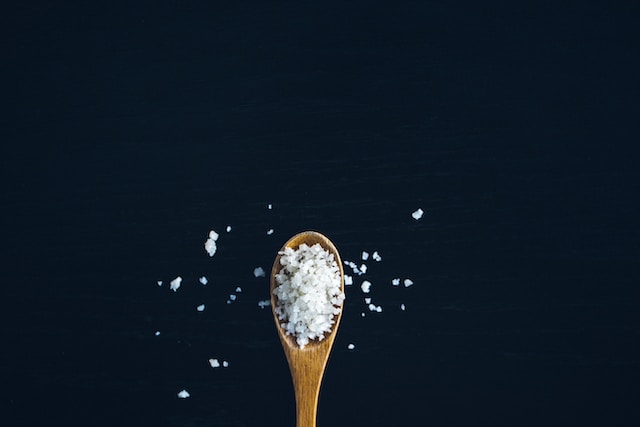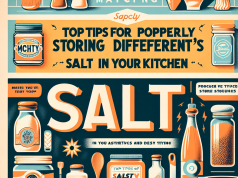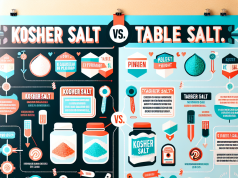Contents
What is the difference between sea salt and table salt?
Sea salt and table salt are both types of salt that are commonly used in cooking and seasoning. However, there are some key differences between the two.
Table salt is highly processed and is typically made from rock salt that is mined from underground salt deposits. The salt is then heavily refined to remove any impurities and is often fortified with iodine. Table salt usually has additives such as anti-clumping agents to help it flow more easily.
Sea salt, on the other hand, is made by evaporating seawater. It is not highly processed and often contains trace minerals that are not found in table salt. Sea salt is less likely to contain additives like anti-caking agents, making it a more natural option.
In terms of taste, many people find that sea salt has a more complex and nuanced flavor than table salt. Its texture can also be coarser and more irregular.
Overall, while sea salt and table salt can be used interchangeably in most recipes, they do have some notable differences in their composition and taste.
Introduction
When it comes to cooking, salt is an essential ingredient. It is used to not only add flavor to the dishes but also to preserve them. But not all salts are created equal; there are different types of salts, with some of the most common ones being sea salt and table salt. In this blog post, we will discuss the difference between these two types of salts.
What is Sea Salt?
Sea salt is made by evaporating seawater. It is usually unrefined and contains trace minerals such as magnesium, potassium, and calcium. The minerals give sea salt its distinct flavor and texture. Sea salt is available in both coarse and fine grains and is often used as a finishing salt.
Types of Sea Salt
There are different types of sea salt:
- Fleur de sel: This is a type of sea salt that is hand-harvested from the surface of salt pans. It has a delicate flavor and is often used as a finishing salt.
- Hawaiian sea salt: This is a type of sea salt that is harvested from the waters surrounding Hawaii. It has a red color due to the presence of volcanic clay.
- Black sea salt: This is a type of sea salt that is mixed with activated charcoal. It is often used as a finishing salt.
What is Table Salt?
Table salt is made by evaporating brine from salt mines. It is highly refined and stripped of its minerals. The refining process gives it a uniform texture and makes it easy to use in recipes. Table salt is often fortified with iodine, which helps prevent iodine deficiency.
Types of Table Salt
There are different types of table salt:
- Iodized salt: This is a type of table salt that is fortified with iodine. It helps prevent thyroid problems and is often used in processed foods.
- Kosher salt: This is a coarse-grained salt that is often used in kosher cooking. It is less salty than table salt and is easier to pick up with the fingers.
- Pink Himalayan salt: This is a type of table salt that is mined from the Khewra Salt Mine in Pakistan. It has a pink color due to the presence of iron oxide.
The Difference between Sea Salt and Table Salt
The main difference between sea salt and table salt is their texture and mineral content. Sea salt has a coarser texture and contains trace minerals, while table salt is highly refined and stripped of its minerals. Sea salt also has a distinct flavor and is often used as a finishing salt, while table salt is used in recipes.
Conclusion
In summary, sea salt and table salt are two types of salts that are commonly used in cooking. While they serve the same purpose of adding flavor to dishes, they differ in texture and mineral content. It is up to personal preference which one to use, as long as they are used in moderation.
References
Frequently Asked Questions (FAQs)
What is the difference between sea salt and table salt?
Sea salt and table salt are both used to season food, but they are not the same. Here are the main differences between these two types of salt:
- Origin: Sea salt is produced by evaporating seawater. Table salt is usually mined from underground salt deposits.
- Processing: Sea salt is harvested through natural evaporation, whereas table salt is heavily processed to remove impurities and to add anti-caking agents.
- Texture: Sea salt usually has a larger, coarser grain than table salt, which can be finer and more powdery.
- Flavor: Sea salt can have a more complex and nuanced flavor than table salt, depending on the minerals and trace elements it contains.
- Usage: Sea salt is often used as a finishing salt to add a bit of crunch and flavor to dishes, while table salt is commonly used in cooking and baking.
Ultimately, the choice between sea salt and table salt comes down to personal preference and the intended use. Just keep in mind that both types of salt contain sodium, and too much sodium can be harmful to your health.
Understanding the Different Types of Salt
Sea Salt
Sea salt is a type of salt that is obtained by evaporating seawater. It is usually minimally processed and retains its natural minerals. Sea salt can vary in taste and texture, depending on where it is harvested from.
Himalayan Salt
Himalayan salt is a type of rock salt that is mined from the Khewra Salt Mine in Pakistan. It is considered to be one of the purest forms of salt, as it is untouched by environmental pollutants. Himalayan salt has a pinkish hue and contains trace minerals like magnesium and potassium.
Kosher Salt
Kosher salt is a type of coarse-grained salt that is usually used in Jewish cuisine. It got its name from the fact that it was traditionally used in the process of koshering meats. Kosher salt is less dense than table salt and has a more subtle flavor.
Outbound link: Learn more about salt on Wikipedia
Overview
- Sea salt is obtained from evaporated seawater and table salt is mined from underground salt deposits.
- Sea salt is usually more expensive than table salt.
- Sea salt contains trace minerals, such as magnesium, potassium, and calcium, while table salt is usually fortified with iodine.
- Sea salt has larger crystals and a coarser texture compared to table salt, which is finely ground.
- The taste of sea salt is often described as briny or minerally, while table salt is more uniform in flavor.
- Some people prefer sea salt as it is seen as a more natural and unprocessed option, while others prefer table salt for its convenience and consistent taste.








































